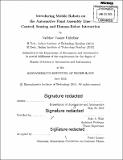| dc.contributor.advisor | Julie A. Shah. | en_US |
| dc.contributor.author | Unhelkar, Vaibhav Vasant | en_US |
| dc.contributor.other | Massachusetts Institute of Technology. Department of Aeronautics and Astronautics. | en_US |
| dc.date.accessioned | 2015-09-17T19:14:00Z | |
| dc.date.available | 2015-09-17T19:14:00Z | |
| dc.date.copyright | 2015 | en_US |
| dc.date.issued | 2015 | en_US |
| dc.identifier.uri | http://hdl.handle.net/1721.1/98814 | |
| dc.description | Thesis: S.M., Massachusetts Institute of Technology, Department of Aeronautics and Astronautics, 2015. | en_US |
| dc.description | Cataloged from PDF version of thesis. | en_US |
| dc.description | Includes bibliographical references (pages 101-107). | en_US |
| dc.description.abstract | Traditionally, robots in manufacturing have been deployed in caged, static and predictable environments. Advances in robotics are enabling industrial robots to emerge from these traditional habitats, and enter the final assembly to work along side humans. My thesis contributes to this effort through development of a mobile robot capable of operating on final automotive assembly lines to assist humans. Several algorithmic as well as design challenges exist when mobile robots enter the unpredictable, human-centric and time-critical environment of final assembly. My primary focus is on achieving autonomous mobility, a precursor for introducing robots to operational factory floors. Automotive assembly lines present a distinct challenge in form of surfaces that are dynamic, i.e., the conveyor belts which ferry cars in the factory. I develop a control strategy to enable autonomous navigation on such dynamic surfaces, and design a sensing module capable of detecting the conveyor belts. The designed system is tested in simulation, implemented on hardware and evaluated on an operational, automotive factory floor. Evaluation in factory establishes preliminary success in the designed robotic system. Interesting, qualitative observations while introducing a robot in a real environment also emerge, and motivate need for enhancing the interaction capability of robots for time-critical tasks in human-centric environments. Towards this, we carry out a human subject experiment (N = 24) comparing the performance of the robot to that of a human assistant in an analogue assembly line environment. Results from the experiment provide a better understanding of the factors that impact fluency of interaction and inform the design of a more effective mobile robotic assistant. This work introduces mobile robots on the automotive assembly lines right next to people, thereby paving the way for utilizing them to assist busy, human associates in the myriad tasks involved in final assembly of cars. | en_US |
| dc.description.statementofresponsibility | by Vaibhav Vasant Unhelkar. | en_US |
| dc.format.extent | 107 pages | en_US |
| dc.language.iso | eng | en_US |
| dc.publisher | Massachusetts Institute of Technology | en_US |
| dc.rights | M.I.T. theses are protected by copyright. They may be viewed from this source for any purpose, but reproduction or distribution in any format is prohibited without written permission. See provided URL for inquiries about permission. | en_US |
| dc.rights.uri | http://dspace.mit.edu/handle/1721.1/7582 | en_US |
| dc.subject | Aeronautics and Astronautics. | en_US |
| dc.title | Introducing mobile robots on the automotive final assembly line : control, sensing and human-robot interaction | en_US |
| dc.type | Thesis | en_US |
| dc.description.degree | S.M. | en_US |
| dc.contributor.department | Massachusetts Institute of Technology. Department of Aeronautics and Astronautics | |
| dc.identifier.oclc | 921147276 | en_US |
